 |
When the distribution of a random variable is continuous rather
than discrete, we will approximate the distribution with either
a discrete distribution or a piece-wise uniform distribution.
In this section we deal with the discrete approximation. We
illustrate this application with a simple-recourse model
of the LP situation used at the beginning of this section.
To approximate the continuous distribution we select K+1
quantile values ranging from 0 to 1.
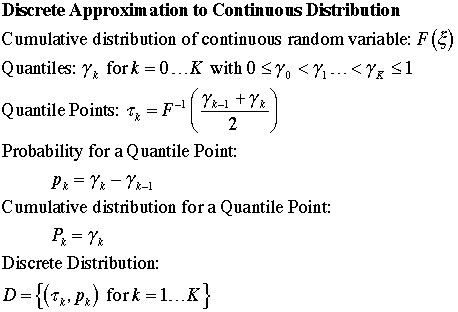
To illustrate, consider a Normal distribution
with mean 54 and standard deviation 10. We divide the probability
range into five intervals using the quantiles: 0, 0.2,
0.4, 0.6, 0.8, 1. The quantile points are computed with the
RV_Inverse function of the Random Variables add-in.

The graph below shows the cumulative distribution
of this discrete approximation (in magenta) along with the
Normal distribution (in blue). The picture shows the steps
as ramps, but the steps are perpendicular at the quantile points.
The approximation sometimes over
estimates
the
continuous cumulative and sometimes underestimates it.
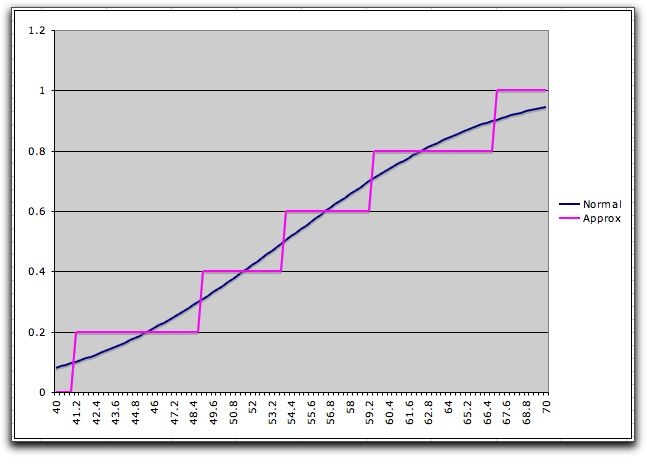
The number of steps and the selection of the
quantiles controls the accuracy of the approximation. |
Simple Recourse |
| |
We return to the ten product
mix problem considered earlier, but now we will solve it as
a simple-recourse model. The master problem below includes
the production variables and the variables computing the resource
usage. |
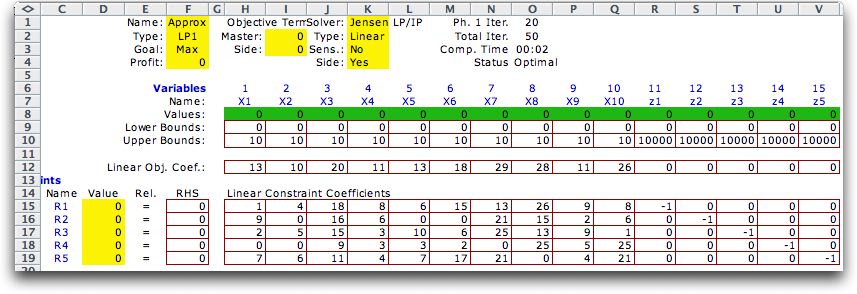
|
| |
To the right of the model we have constructed
tables to compute the necessary probabilities and quantile
points from the quantile values specified by the modeler. Normal
distributions are defined in columns Y through AA. All computations
relating
to these distributions are provided by functions in the Random
Variables add-in. Other distributions could just have
well been used.
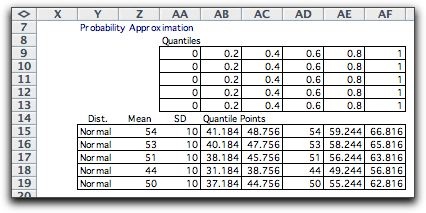
The piecewise linear representation of the expected
recourse costs are expressed in the side model. Build the side
model by choosing Side Model from the Math Programming menu.
Fill in the dialog as below.
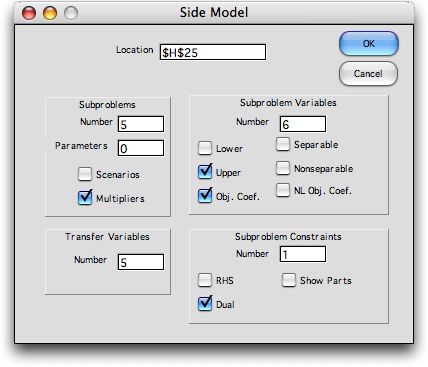
The model is constructed starting in cell H25.
We show the model in two parts below. The first part identifies
the linking variables through the indices in row 30. Columns
J through O provide information on T and D.
The variables and the associated W matrix
are in columns P through V. For definitions of the matrix terms,
see the side
model discussion. The multipliers in column I represent
indicate the penalties associated with the violating the resource
constraints. For this discussion we charge $1 for each unit
of resource shortage and $0 for each unit of resource overage.
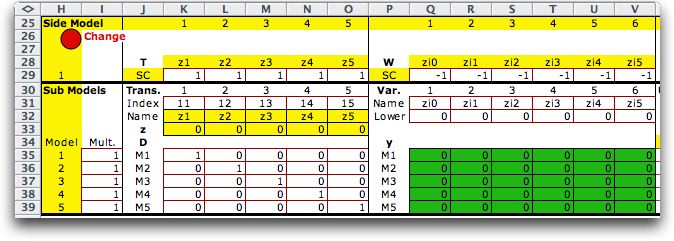
The upper bounds defining
the piecewise approximation are in columns W through AB. The
associated objective coefficients are in AC through AH.
The numbers in these cells are linked by formulas to the table
constructed for the piecewise linear approximation. For details,
see the demonstration workbook for this section.
The constraints
in AK require the equality between the linking variables and
the pieces. The relation and limit of the side constraints are
in cells AK32 and AK33 respectively.
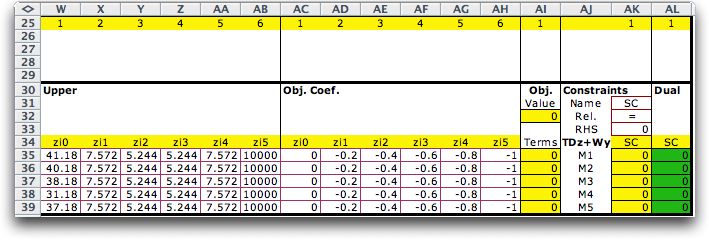
|
Solution |
| |
Clicking the Solve button at the top
of the page provides the solution shown below. The resource
usage variables, z1 through z5, are in both the master and
subproblems. The production variables are x1 through x8. The
green cells in the side model show the results for the pieces
of the piecewise linear form. |
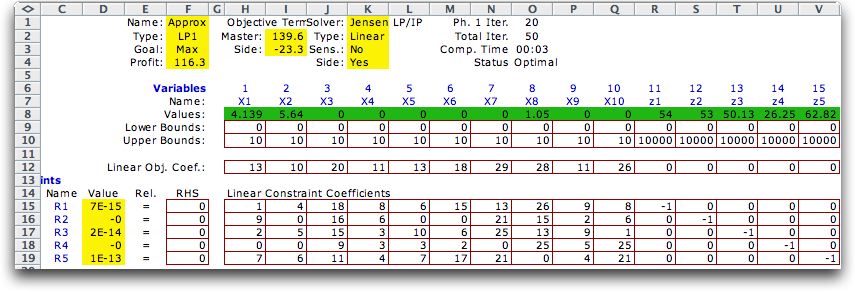
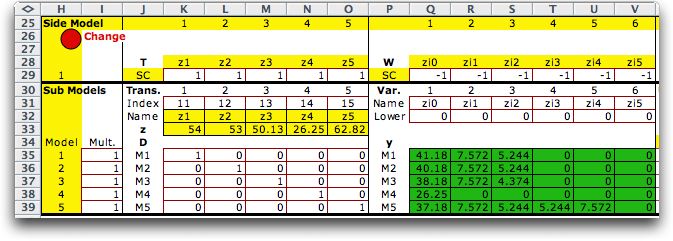
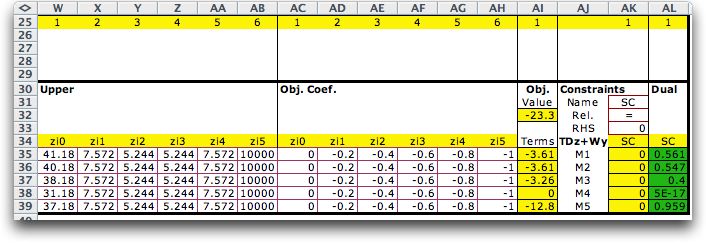
|
| |
The important point of this discussion
is that simple recourse is relatively easy to model and solve
with linear programming. The individual stochastic part of
the problem is modeled with a deterministic equivalent. The
expected cost of the resources are piecewise approximations
of the continuous expected cost function.
More accuracy may
be obtained by adding more pieces to the approximation or more
accurately representing the expected value in the region of
the optimum. The search is aided by the dual variables of the
side constraints shown in column AL of the figure above. This
approach is considered below. |
A Better Approximation |
| |
The solution obtained above provides
information about the optimum use of the resources of
the product mix problem. In particular the dual variables shown
in column AL show the probabilities that the resources will
be violated at the optimum solution. The first resource,
represented by the first side constraint, has a dual variable
of 0.561. Solution uses 54 units of R1 and the mean availability
of R1 is 54 so really the risk of violating the resource is
0.5. Our piecewise approximation causes the error of 0.061.
We
obtain a more accurate approximation by defining quantile points
that emphasize the probability range 0.5 through 0.6.

The cumulative distribution shown below is more
accurately represented in this range, while it is not well
approximated outside the range. This feature will have usefulness
for the simple recourse model.
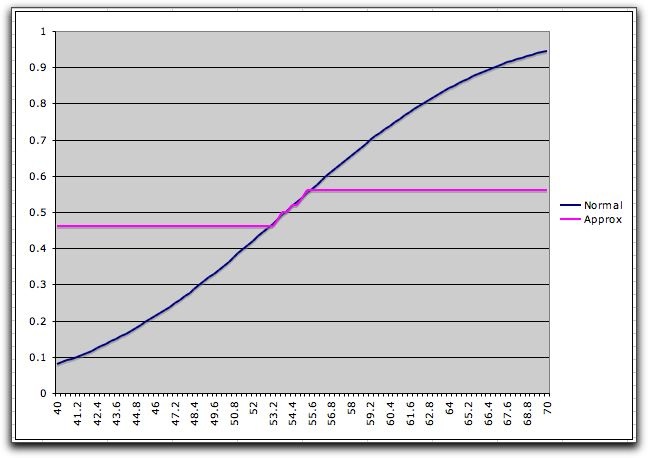
Based on the solution found with the rough
approximations for the Normal distributions, we modify the
quantiles under consideration to cover a smaller range of probabilities.
In
the table below
we define five intervals in a 0.1 range for each random variable.
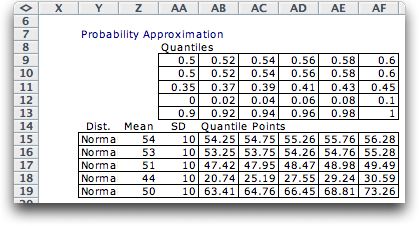
The optimum solution is shown below for the
revised quantiles. The value of the expected recourse cost
is quite distorted by the approximation,
so the optimum objective function is markedly different for this
solution. The approximation adds a negative constant to all solutions,
so the decision values obtained are the optimum for the more
accurate representation. The slopes of the terms of the objective
function of the LP determine the optimal solution, and the
slopes in the smaller range are much more accurate
than with the first approximation. |
|
| |
The dual solution provides an
interesting interpretation. The dual indicates the risk that
each constraint will be violated when the optimum solution
is pursued. Clearly the last constraint, indicated by M5, is
the most important constraint. The solution will have a shortage
with respect to this RHS in over 95% of the future realizations.
Apparently, the profit obtained by using more of this resource
is sufficient to pay for the cost of its violation. Of course
the optimum solution and the risks depend on the penalties.
The two solutions are compared in the table.

|
Different Penalties |
| |
The multiplier column holds the penalties for
constraint violation. For the example below, we have set different
penalties for each constraint. We are using the simple equal
probability approximation of the resource availability distributions.
Of course the solution depends on the weights. To find the risk
values, you must divide the dual values by the weights. |

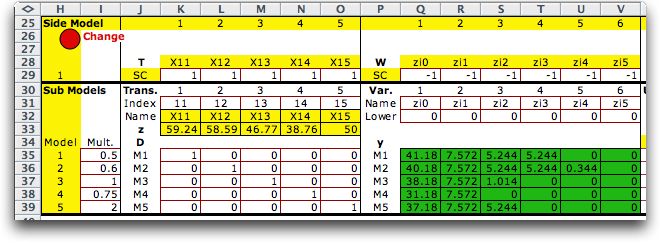

|
| |
The methods described on this page can be used
to solve a variety of interesting stochastic programming problems.
Each random RHS adds a collection of variables representing the
parts of a piece-wise linear function. The parameters of the
parts are easily determined by quantiles selected by the user.
The quantiles can be varied to obtain more accurate representations
in the region of the optimum. The random variables add-in
allows a large variety of distributions for the random variables
with little or no changes in the model. |
| |
|



